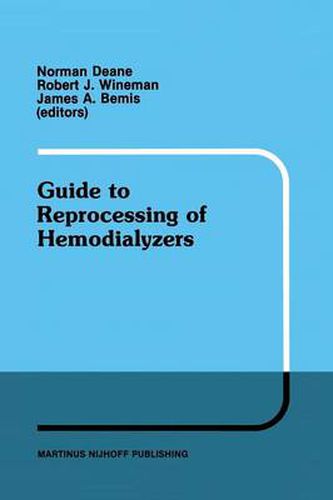Readings Newsletter
Become a Readings Member to make your shopping experience even easier.
Sign in or sign up for free!
You’re not far away from qualifying for FREE standard shipping within Australia
You’ve qualified for FREE standard shipping within Australia
The cart is loading…






This title is printed to order. This book may have been self-published. If so, we cannot guarantee the quality of the content. In the main most books will have gone through the editing process however some may not. We therefore suggest that you be aware of this before ordering this book. If in doubt check either the author or publisher’s details as we are unable to accept any returns unless they are faulty. Please contact us if you have any questions.
The purpose of this book is to provide information for the nephrologist to gain a perspective on the medical, scientific, and technical aspects of reprocess ing of hemodialyzers. The book is also designed to serve the needs of the associated medical, nursing, and technical staffs of dialysis facilities for data on reuse of hemodialyzers. As an information source, the book will prove to be useful for those who may be considering reprocessing of dialyzers, as well as persons who are currently involved in this aspect of the practice of nephrology. We have focused on the clinical and technological aspects of hemodialyzer reprocessing and have not dealt with socioeconomic considerations. We do wish to share with physicians performing hemodialysis several observations we have made as a result of assembling this volume. We believe that hemodialyzer reuse has had a beneficial impact on the quality of care for hemodialysis patients in consideration of the following factors. There is an increased awareness of membrane biocompatibility issues that has been brought to the forefront with the application of reuse. Utilization ofhemodialyzer reprocess ing has enabled nephrologists . to compare the effect of various measures on biocompatibility when the patient is exposed to either a new or a reprocessed device. Previously, few readily available comparisons existed. In the practice of dialysis, water quality has always been of considerable importance. With the advent of widespread hemodialyzer reprocessing, the issues of water bacteriology and water quality have become more prominent.
$9.00 standard shipping within Australia
FREE standard shipping within Australia for orders over $100.00
Express & International shipping calculated at checkout
This title is printed to order. This book may have been self-published. If so, we cannot guarantee the quality of the content. In the main most books will have gone through the editing process however some may not. We therefore suggest that you be aware of this before ordering this book. If in doubt check either the author or publisher’s details as we are unable to accept any returns unless they are faulty. Please contact us if you have any questions.
The purpose of this book is to provide information for the nephrologist to gain a perspective on the medical, scientific, and technical aspects of reprocess ing of hemodialyzers. The book is also designed to serve the needs of the associated medical, nursing, and technical staffs of dialysis facilities for data on reuse of hemodialyzers. As an information source, the book will prove to be useful for those who may be considering reprocessing of dialyzers, as well as persons who are currently involved in this aspect of the practice of nephrology. We have focused on the clinical and technological aspects of hemodialyzer reprocessing and have not dealt with socioeconomic considerations. We do wish to share with physicians performing hemodialysis several observations we have made as a result of assembling this volume. We believe that hemodialyzer reuse has had a beneficial impact on the quality of care for hemodialysis patients in consideration of the following factors. There is an increased awareness of membrane biocompatibility issues that has been brought to the forefront with the application of reuse. Utilization ofhemodialyzer reprocess ing has enabled nephrologists . to compare the effect of various measures on biocompatibility when the patient is exposed to either a new or a reprocessed device. Previously, few readily available comparisons existed. In the practice of dialysis, water quality has always been of considerable importance. With the advent of widespread hemodialyzer reprocessing, the issues of water bacteriology and water quality have become more prominent.